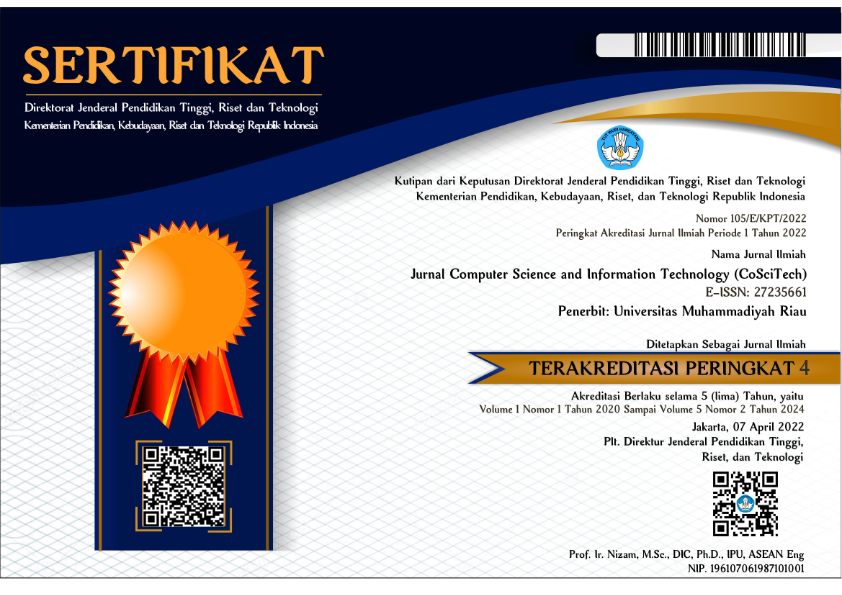Analisis Perbandingan Model Fully Connected Neural Networks (FCNN) dan TabNet Untuk Klasifikasi Perawatan Pasien Pada Data Tabular
Abstract
Electronic Health Records (EHR) store tabular data that is rich in information and play a critical role in supporting decision-making within the healthcare field, particularly for patient care classification. This study evaluates the performance of two artificial intelligence models, Fully Connected Neural Networks (FCNN) and TabNet, in processing tabular data for patient care classification tasks. The findings reveal that both models demonstrate strong performance, with TabNet showing a slight advantage. TabNet achieves an accuracy of 0.74, marginally surpassing FCNN's 0.73. Furthermore, TabNet excels in precision (0.74 vs. 0.72), recall (0.72 vs. 0.71), and F1-Score (0.73 vs. 0.71), highlighting its greater reliability in minimizing false positives and accurately detecting positive cases with a better balance between precision and recall. With its architecture specifically tailored for tabular data and its capacity for direct interpretability, TabNet offers enhanced efficiency and ease of implementation compared to FCNN, which demands more complex data preprocessing. For future research, it is suggested to employ larger and more diverse datasets, explore data with higher feature complexity, and conduct comprehensive hyperparameter tuning to further improve the performance of both models.
Downloads
References
[2] M. Wang, M. S. Pantell, L. M. Gottlieb dan J. Adler-Milstein, “Documentation and review of social determinants of health data in the EHR: measures and associated insights,” Journal of the American Medical Informatics Association, vol. 28, no. 12, pp. 2608-2616, 2021.
[3] M. Karatas, L. Eriskin, M. Deveci, D. Pamucar dan H. Garg, “Big Data for Healthcare Industry 4.0: Applications, challenges and future perspectives,” Expert Systems with Applications, vol. 200, p. 116912, 2022.
[4] V. Jackins, S. Vimal, M. Kaliappan dan M. Y. Lee, “AI-based smart prediction of clinical disease using random forest classifier and Naive Bayes,” The Journal of Supercomputing, vol. 77, no. 5, pp. 5198-5219, 2021.
[5] E. Ismanto, A. Fadlil, A. Yudhana dan K. Kitagawa, “A Comparative Study of Improved Ensemble Learning Algorithms for Patient Severity Condition Classification,” Journal of Electronics, Electromedical Engineering, and Medical Informatics, vol. 6, no. 3, pp. 312-321, 2024.
[6] D. Jiang, G. Hu, G. Qi dan N. Mazur, “A fully convolutional neural network-based regression approach for effective chemical composition analysis using near-infrared spectroscopy in cloud,” Journal of Artificial Intelligence and Technology, vol. 1, no. 1, pp. 74-82, 2021.
[7] L. P. Joseph, E. A. Joseph dan R. Prasad, “Explainable diabetes classification using hybrid Bayesian-optimized TabNet architecture,” Computers in Biology and Medicine, vol. 151, p. 106178, 2022.
[8] G. Verma, M. Kumar dan S. Raikwar, “FCNN: fusion-based underwater image enhancement using multilayer convolution neural network,” Journal of Electronic Imaging, vol. 31, no. 6, pp. 063039-063039, 2022.
[9] K. McDonnell, F. Murphy, B. Sheehan, L. Masello dan G. Castignani, “Deep learning in insurance: Accuracy and model interpretability using TabNet,” Expert Systems with Applications, vol. 217, p. 119543, 2023.
[10] M. Sadikin, “EHR Dataset for Patient Treatment Classification,” Mendeley Data, V1, Jakarta, 2020.
[11] V. Çetin dan O. Yıldız, “A comprehensive review on data preprocessing techniques in data analysis,” Pamukkale Üniversitesi Mühendislik Bilimleri Dergisi, vol. 28, no. 2, pp. 299-312, 2022.
[12] S. Ö. Arik dan T. Pfister, “TabNet: Attentive Interpretable Tabular Learning,” In Proceedings of the AAAI conference on artificial intelligence, vol. 35, no. 8, pp. 6679-6687, 2021.
[13] D. Božić, B. Runje, D. Lisjak dan D. Kolar, “Metrics related to confusion matrix as tools for conformity assessment decisions,” Applied Sciences, vol. 13, no. 14, p. 8187, 2023.
[14] M. Heydarian, T. E. Doyle dan R. Samavi, “MLCM: Multi-label confusion matrix,” IEEE Access, vol. 10, pp. 19083-19095, 2022.













